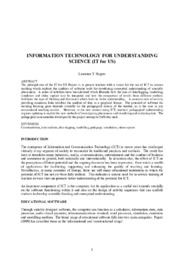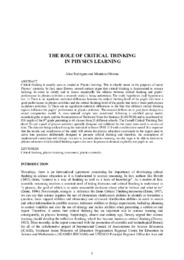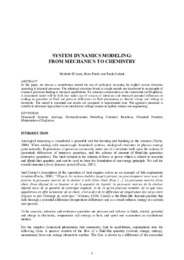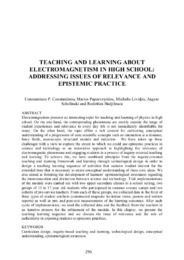Browsing GIREP Conference 2008 Physics Curriculum Design, Development and Validation by Title
Now showing items 14-23 of 23
-
The ideas of 3rd years students of technical schools in Cyprus about light and its properties
(University of Cyprus, 2008)This paper aims to report and investigate the ideas of 18 year-old (3rd year) students of Vocational Education in Technical Schools in Cyprus, about light and its properties. In Technical High School Education physics is ... -
Information technology for understanding Science (it for us)
(University of Cyprus, 2008)The principal aim of the IT for US Project is to present teachers with a vision for the use of ICT in science teaching which exploits the qualities of software tools for developing conceptual understanding of scientific ... -
An innovative inquiry-oriented module on Thermal conductivity: design, development and application
(University of Cyprus, 2008)In line with current trends about developing teaching learning sequences in science education we have designed an innovative inquiry oriented module aiming at providing secondary education students with a comprehensive treatment ... -
Investigating the learning of RLC circuits with The aid of computer-based activities
(University of Cyprus, 2008)The purpose of this study was to get some insight about using computational simulations and modeling activities to promote a better students’ conceptual understanding of RLC circuits. The theoretical framework adopted ... -
It seems easy to float, but is it really? Α Teaching unit for buoyancy
(University of Cyprus, 2008)The teachers’ prior practice indicates that the conceptual understanding of buoyancy among lower secondary school students is often deficient. Therefore we introduced a new teaching sequence in which students are ... -
Modelling and inquiring sound attenuation: design-based research about an ICT enhanced Unit on materials science
(University of Cyprus, 2008)In this paper we present preliminary results of a design-based research about a teaching/learning unit on Sound Attenuation, which is part of a international research-based curriculum project on Materials Science. The ... -
The role of critical thinking In physics learning
(University of Cyprus, 2008)Critical thinking is usually seen as crucial to Physics learning. This is clearly stated in the purposes of many Physics’ curricula. In fact, since Dewey, several authors argue that critical thinking is fundamental to ... -
Striking results with bouncing balls
(University of Cyprus, 2008)In a laboratory activity students study the behaviour of a bouncing ball. With the help of a high-speed camera they can study the motion in detail. Computer modelling enables them to relate the measurement results to the ... -
System dynamics modeling: from mechanics to chemistry
(University of Cyprus, 2008)In this paper, we discuss a contribution toward the use of analogical reasoning by explicit system dynamics modeling of physical processes. The relational structures found in simple models are transferred to an example ... -
Teaching and learning about Electromagnetism in high school: addressing issues of relevance and Epistemic practice
(University of Cyprus, 2008)Electromagnetism presents an interesting topic for teaching and learning of physics in high school. On the one hand, the corresponding phenomena are mostly outside the range of student experiences and relevance to every ...









